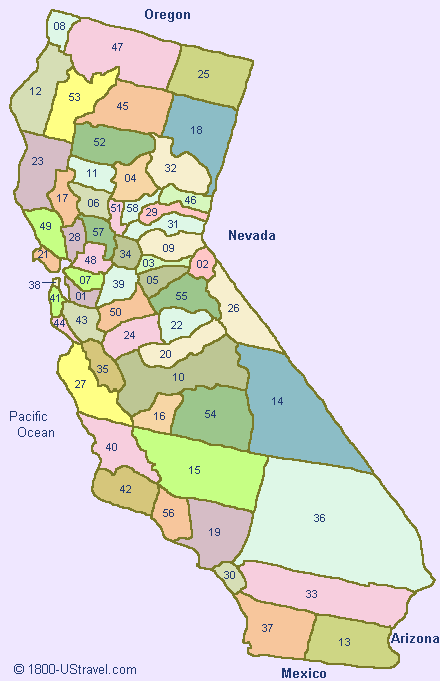California County Breakdown – Map, Population, Trivia & FAQ
California County Breakdown – Map, Population, Trivia & FAQ
Blog Article

Trying to find out what the exact county count in California is? You’re certainly not the only one. Whether it’s for school projects, travel plans, or simple trivia, the magic figure 58 always surfaces, and stillthat short answeronly tells half the story.
This network of counties makes upa tapestry of extremes: sun-drenched coastal hubs, snow-capped alpine districts, fertile Central Valley breadbaskets, and historic mission settlements. Each county carries its own story, forged throughimmigration waves, cutting-edge innovation, and relentless population booms.
Throughout this guide, we’ll explore why California ended up with 58 counties, the real responsibilities counties shoulder, and the record-holders—from the tiniest to the most populous. When we’re done, you’ll have the numbers—and be ready to ace any quiz with confidence.
How the Golden State Reached 58 Counties
When California joined the Union in 1850, the map looked nothing like today’s. A tidal wave of forty-niners and immigrants pushed officials to subdivide vast districts. By the end of the 1870s, the count had ballooned to over five dozen counties, and by 1907 the remaining gaps were closed, locking in the canonical figure of fifty-eight.
Legislative records show that most new counties were born how many california counties because of three overlapping forces:
- Hundreds of rugged miles turned routine business into week-long trips.
- Revenue battles between miners and farmers triggered secession campaigns.
- Language and immigrant communities sought their own seats.
By 1920, the political map hardened. Right now, every effort to create county #59 stalls, causing commentators to dub the era of county making decisively over.
Landscape and Climate Diversity Across California Counties
Stretch a string from the Smith River watershed to border-side Calexico, and you’ll traverse every Köppen zone short of tundra. Pacific-facing districts soak up fog-cooled summers, while basin counties in the Central Valley battle drought cycles.
- Alpine districts such as El Dorado, Tuolumne, and Sierra host ski resorts.
- Sacramento–San Joaquin fringe counties mix levee farms with wetlands.
- Off-shore authorities like Santa Barbara license film crews on beaches.
Such variety explains why no two counties share identical economies. Topography dictates everything from wage levels to weekend hobbies.
Behind the Scenes at the County Level
In California’s layered structure, cities tackle local bylaws, but counties are tasked with the bread-and-butter functions that hold civilisation together. Life’s paperwork trail—vital records, coroner reports, property deeds—all are archived at the registrar of voters.
County law-enforcement offices patrol towns too small for police forces, while county benches hear civil suits. Social-services bureaus administer vaccination campaigns. Tax-allocation showdowns occur in monthly Board of Supervisors sessions.
Spotlight: Los Angeles County’s Scale
Contra Costa partners with nearby cities for animal control, highlighting how adaptable county structures can be. One template doesn’t fit all when land areas shift from 47 to 20 000 sq mi.
In the end, county halls bridge Sacramento’s big laws and local reality. Understanding their remit empowers voters.
Demographic and Fiscal Highlights
Home to over 39 million residents, but those citizens collects in dramatic clumps. LA’s single jurisdiction accounts for roughly a quarter. At the other extreme, remote Alpine rarely tops 1 200 inhabitants.
- Largest population: Los Angeles
- Smallest by residents: County of Alpine
- Biggest footprint: San Bernardino
- Compact footprint: San Francisco
Fiscal bandwidth mirrors population spread. Tech-centric jurisdictions report six-figure median incomes, while interior ag counties depend on seasonal labour influxes. Such economic polarity drive school funding debates every decade.
Memorising these recordsmakes relocation plans simpler: county metrics shape property taxes and commute times.
The Ultimate California County Circuit
Adventure-hungry drivers, visiting every single county ranks as a top geo-challenge. A popular itinerary kicks off in the south-west corner, follows Highway 101 past surf towns, swings through Monterey, then threads through rice-field flats and orchard grids, before ascending into the high Sierra for ghost towns and mining museums.
Three-Day County Clusters
- Southern Swing – Mission trail coast; a baker’s dozen of stops in three days.
- Valley Ribbon – Ventura to Sacramento; flat-land express.
- Shasta & Siskiyou Turn – mountain lakes and volcano cones; jaw-dropping vistas.
Finish the circuit in El Centro, having logged 1 400–2 000 miles. After that, you can brag that you’ve lived the answer to the county-count question—because you’ve seen them all!
FAQ
Curious about California’s 58 counties? The following FAQ has you covered.
What is the total number of counties in CA?
California officially recognises 58 counties—a total locked in for over a century. Check any authoritative source, and you’ll find the same figure: precisely fifty-eight.
Which county has the largest population in California?
Los Angeles County tops the list, hosting a population greater than that of many U.S. states. Its size stems from historic migration waves, a diverse economy, and global cultural pull.
Least populous California county?
Tiny Alpine County sits at the bottom of the population chart, with fewer than 1 200 inhabitants. Location along rugged mountain corridors keeps growth modest, preserving a frontier feel.
Largest county by land size?
Geographic titan San Bernardino County encompassing deserts, mountains, and metro suburbs alike. Its sheer scale means climate zones shift from alpine snow to Mojave heat within county lines.
What historical events fixed the number at 58?
Gold-rush politics, rail expansion, and farmland disputes carved today’s boundaries, with the final adjustments ratified in 1907. Every modern effort to create a new county stalls in committee or dies at the ballot box.
Can new counties still be created in California?
Technically, the California Constitution leaves the door open, though the process is arduous. Financial viability studies plus state-level sign-off deter most would-be county creators. That’s why no county lines have moved since the early 1900s.
Why are counties important to everyday life?
Behind the scenes, counties keep daily life functioning: voter registration, deed recording, health clinics, and sheriff patrols. Remove counties from the equation, and civil society would struggle to operate.
Report this page